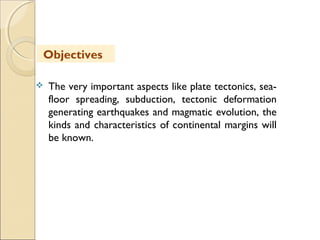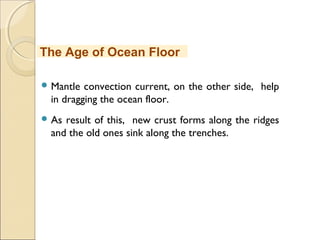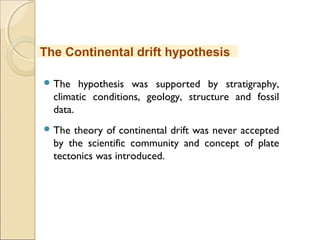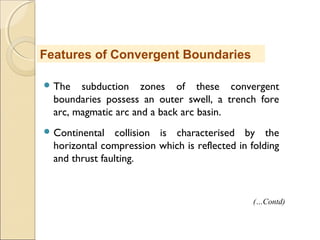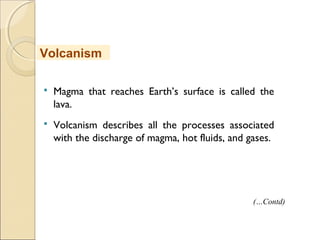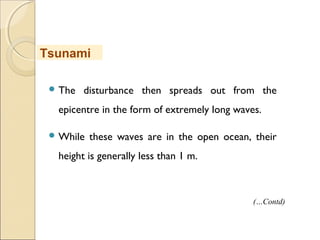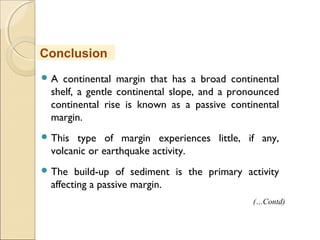The Continental Margins
- 1. Topic of the lesson The Continental MarginsThe Continental Margins By Prof.A. Balasubramanian & Dr. K.N. Somashekar Centre for Advanced Studies in Earth Science University of Mysore, India
- 2. Introduction The Earth’s Crust The Asthenosphere The Age of Ocean Floor The Continental drift hypothesis The Concept of Plate Tectonics Types of Plate Movement Volcanism Conclusion Table of ContentsTable of Contents
- 3. After attending this lesson, the user should be able to understand the importance of continental margins, in the context of earth and oceanographic studies. The continental margin is the zone of the ocean floor that separates the thin oceanic crust from thick continental crust. The continental margins are the submerged continental shelf and slope zones, forming the outer edge of major landmasses. Objectives
- 4. The very important aspects like plate tectonics, sea- floor spreading, subduction, tectonic deformation generating earthquakes and magmatic evolution, the kinds and characteristics of continental margins will be known. Objectives
- 5. Oceanography is an interesting subject. Geological oceanography deals with a lot of unique aspects of the oceans including the ocean morphology and relief, continental margins, tectonic processes acting on the ocean bottoms, marine mineral resources, and the deep sea deposits. The subject also focuses on the never ending dynamic processes like ocean waters, ocean currents and their impacts with reference to space and time. Introduction (…Contd)
- 6. Understanding the tectonic disposition and movement of crustal plates are an important part while studying the earth and atmospheric sciences, in general and oceanography, in particular. The continental margins and the deep ocean basins are the two major aspects to be understood in this subject. This lesson is on the characteristics of continental margins. Introduction
- 7. Based on the seismic observations, the earth’s lithosphere is made of three major layers as the crust, mantle and the core. The Crust is the outermost solid layer of the earth. Although, the crust is composed of igneous, sedimentary and metamorphic rocks, more than 95% of the rocks are of igneous in origin. The Earth’s Crust (…Contd)
- 8. The crust is not a layer of uniform thickness. It is thinnest beneath the oceans and thickest under the continents. These rock masses are extending 5 to 70 kilometres downwards from the surface up to the Mohorovicic discontinuity which is called as Moho. The crustal layer that is underlying the continents is called as continental crust. The crustal layer found under the oceans is called as oceanic crust. The Earth’s Crust
- 9. The Continental crust is thicker – about 35 to 70 km. This layer is usually older than the oceanic crust. Some rocks of these may date back to 4 billion years. The Continental Crust (…Contd)
- 10. The Continental crust is composed mostly of rocks containing minerals such as feldspar and quartz, which form less-dense, lighter-coloured, granitic masses. This less dense mass floats on the mantle, in the state of acquiring a balance, due to the concept of Isostasy. The Continental Crust
- 11. The oceanic crust is about 7 to 10 km in thickness. The oceanic crust is made up of rocks containing minerals that are high in iron and magnesium. These masses are much dense and dark-coloured. The Oceanic Crust (…Contd)
- 12. They are of basaltic in composition. The basaltic rocks of the oceanic crust are relatively young. None of them is older than 200 million years. The Oceanic Crust
- 13. The soft layer which is underlying beneath the oceanic and continental crust, is known as the Asthenosphere. The Asthenosphere is composed of partially molten material that is heated unevenly by the radioactive decay of mass present below which include both the mantle and the hot core. The Asthenosphere (…Contd)
- 14. The earth’s temperature increases with reference to depth. At about 100 km depth, inside the lithosphere, the temperature reaches to a maximum of 1,400 degree celcius. This temperature condition is enough to melt the materials present in most of the rocks. The Asthenosphere (…Contd)
- 15. As a result, the rock masses melted and are able to flow slowly. On this zone, the rigid plates lying above are found to be floating or drifting. The drifting of plates away from each other leads to spreading of ocean floors and creation of rift valleys. In some areas, there is a collision and subduction of merging plates. The Asthenosphere
- 16. The Age of the ocean floor is about 200 million years, although age of the earth is estimated about 4600 million years. Such a geologically younger age is found due to ocean floor spreading. The Mid oceanic ridges are continuously filled by magma which cools and helps in expanding or spreading of ocean floor. The Age of Ocean Floor (…Contd)
- 17. Mantle convection current, on the other side, help in dragging the ocean floor. As result of this, new crust forms along the ridges and the old ones sink along the trenches. The Age of Ocean Floor
- 18. The continental margins are the submerged continental shelf and slope zones, forming the outer edge of a major landmass. The Continental margins represent the shallowest parts of the oceans. The Continental Margins (…Contd)
- 19. The differenc between the composition of the continental and oceanic crusts are fundamental to continental margin development. The difference in densities and isostatic balance between the continental and oceanic blocks are reflected on the continental slope. The Continental Margins (…Contd)
- 20. The shallowest part of a continental margin, extending seaward from the shore, is the continental shelf. Seaward of the continental margin is the Ocean Basin. The Continental Margins
- 21. It was Alfred Luthar Wegener (1880-1930), a German Meteorologist, who proposed the theory of continental drift. It was cited that the Earth’s continents had once been united as a single landmass that broke apart and moved as continental drift. The Continental drift hypothesis (…Contd)
- 22. This super-continent is called as Pangaea, a Greek word that means “all the earth”. This concept also suggested that the Pangaea began to break apart about 200 million years ago. Since that time, the continents have continued to slowly move and came to their present positions. The Continental drift hypothesis (…Contd)
- 23. Wegener was the first to put forward his ideas. He assembled the continents just like a puzzle like fit of continental coastlines on either side of the Atlantic Ocean. For Wegener, these gigantic puzzle pieces which just the beginning. The Continental drift hypothesis (…Contd)
- 24. The hypothesis was supported by stratigraphy, climatic conditions, geology, structure and fossil data. The theory of continental drift was never accepted by the scientific community and concept of plate tectonics was introduced. The Continental drift hypothesis
- 25. The world’s widely accepted theory is the theory of plate tectonics. It was formulated in the late 1960s. According to this concept, the Earth's crust and upper mantle consist of moving plates lying above a weaker semi-plastic layer called as the asthenosphere. The Concept of Plate Tectonics (…Contd)
- 26. The theory revolutionized the geological sciences in the 1960s by combining the earlier idea of continental drift and the new concept of seafloor spreading into a coherent whole. It explains how tectonic plates move and shape Earth’s surface. The Concept of Plate Tectonics (…Contd)
- 27. The lithosphere is made up of tectonic plates. These tectonic plates are able to move because the earth’s lithosphere has a higher strength than the underlying asthenosphere. Plate tectonics provides the framework for interpreting the history and character of the continental margins. The Concept of Plate Tectonics (…Contd)
- 28. The plate movements and the basic difference in the density of oceanic and continental crustal units initiate the structural pattern of continental margins and result in a tectonic classification of coastlines as active (Pacific, leading edge) or passive (Atlantic, trailing edge) margins, each of which have certain fundamental characteristics. The Concept of Plate Tectonics
- 29. The cause of plate movement is not accessible to anybody’s direct observation. The various features of plate movement, and the increased heat flow along the mid-oceanic ridges are consistent with the idea that plate movement is caused by convection in the mantle. The Convection Currents (…Contd)
- 30. The driving force behind the convection is heat generated by radioactive decay in the earth. The heat released by this decay (radiogenic heat) is transferred by convection or (slow movement of hot, plastic rock) to the surface of the earth. The Convection Currents (…Contd)
- 31. Scientists think that these convection currents are set in motion by subducting slabs. The rising material in the convection current spreads out as it reaches the upper mantle and causes both upward and sideways forces. These forces lift and split the lithosphere at divergent plate boundaries. The Convection Currents (…Contd)
- 32. As the plates separate, material rising from the mantle supplies the magma that hardens to form new ocean crust. The downward part of convection current occurs where a sinking force pulls tectonic plates downward at convergent boundaries. The Convection Currents
- 33. The data collected from topographic, sedimentary, and paleomagnetic research, prompted the scientists to propose the concept of seafloor spreading. Seafloor spreading is the process by which new oceanic crust is formed at the ocean ridges. The crust slowly moves away from the spreading centre, until it is subducted and recycled at deep-sea trenches. The Sea Floor Spreading (…Contd)
- 34. Deep-seated magma is also expected to intrude into the ocean floor along a ridge and fills the gap that is created. When the molten material solidifies, it becomes new oceanic crust. The continuous spreading and intrusion of magma result in the addition of new oceanic crust. The Sea Floor Spreading (…Contd)
- 35. Two halves of the oceanic crust spread apart slowly, and move apart like a conveyor belt. The far edges of the oceanic crust sink beneath the continental crust. As it descends, water and the minerals cause the oceanic crust to melt, forming a new magma. This magma rises and forms a new part in the continental crust. The Sea Floor Spreading
- 36. Continental shelves vary greatly in width, averaging 60 km wide. The average depth of the water above continental shelves is about 130 m. Beyond the continental shelves; the sea-floor drops away quickly to depths of several kilometres, with slopes averaging nearly 100 m/km. Spread of Continental Margins (…Contd)
- 37. These sloping regions are the continental slopes. The gently sloping zone with the accumulation of deposits from turbidity currents that forms at the base of the continental slope is called as continental rise. Spread of Continental Margins (…Contd)
- 38. A continental rise can be of several kilometres in thickness. The rise gradually becomes thinner and eventually merges with the sediments of the seafloor beyond the continental margins. Spread of Continental Margins
- 39. Earth’s tectonic plates have been named based on the overlying landmasses and oceans. There are about 15 major plates existing on the earth’s surface. They are namely Plates and Plate Boundaries (…Contd)
- 40. The line where the two plates meet each other is called as a plate boundary. Plates and Plate Boundaries
- 41. The plates are all moving in different directions and at different speeds. The rate of movement is from 2 cm to 10 cm per year. During their movements, the plates may crash together, pull apart, or sideswipe each other. Types of Plate Movement (…Contd)
- 42. Most of the movement occurs along narrow zones between plates where the results of plate-tectonic forces are most evident. There are basically three different types of plate boundaries exiting in the world as divergent, convergent, and transform boundaries. Types of Plate Movement
- 43. Divergent boundaries are regions where two tectonic plates are moving apart and are called divergent boundaries. Most divergent boundaries are found along the seafloor, where they form mid ocean ridges. Divergent Plate Boundaries (…Contd)
- 44. The actual plate boundary is located in a fault- bounded valley called as an oceanic rift, which forms along a ridge. Almost all divergent boundaries are characterised by the high heat flow, active volcanism, and continuing earthquakes. Divergent Plate Boundaries (…Contd)
- 45. Although most divergent boundaries form ridges on the ocean floor, some divergent boundaries exist on the continents. When continental crust begins to separate, the stretched crust forms a long, narrow depression called a rift valley. Divergent Plate Boundaries (…Contd)
- 46. The rift valley which is under formation currently is in East Africa. The rifting might eventually lead to the formation of a new ocean basin. It is the divergent plate boundaries that split the continents move them apart and create new continental margins. Divergent Plate Boundaries
- 47. The oceanic crusts that are generated at the divergent plate boundaries are composed of form kinds of geological layers. They are the deep marine sediments, pillow basalts, sheeted dykes and the gabbroic layer. Features of Divergent Plate Boundaries (…Contd)
- 48. It is also expected to generate basaltic magmatism due to decompression melting of the mantle. Seawater is heated along with these sediments which may create mud volcanoes. Features of Divergent Plate Boundaries
- 49. Convergent boundaries occur where two plates slide towards each other to form either a subduction zone or continental collision. At convergent boundaries, two tectonic plates are expected to move toward each other. Convergent Plate Boundaries (…Contd)
- 50. When two plates collide, the denser plate eventually descends below the other, “less-dense plate”. This process is called as subduction. This convergence can create the most remarkable structural and topographic features on the earth’s surface. Deep ocean trenches are the typical examples. Convergent Plate Boundaries
- 51. The subduction zones of these convergent boundaries possess an outer swell, a trench fore arc, magmatic arc and a back arc basin. Continental collision is characterised by the horizontal compression which is reflected in folding and thrust faulting. Features of Convergent Boundaries (…Contd)
- 52. Magma is also generated at the subduction zones. Andesitic and silicic magmas processes also create low temperature high pressure facies near the trenches. Continents grow larger due to addition of crusts at some parts. Features of Convergent Boundaries
- 53. There are three types of convergent boundaries, classified according to the type of crust involved, and on the differences in density of the crustal material. They are 1. The convergence of two oceanic plates (O-O Type) 2. The convergence of a continental plate and an oceanic plate (C-O Type) and 3. The convergence of two continental plates (C-C Type). Types of Convergent Plate Boundaries
- 54. In the oceanic-oceanic convergent boundary, a subduction zone is formed when one oceanic plate, which is denser as a result of cooling, descends below another oceanic plate. The process of subduction creates a deep-sea trench. Oceanic-Oceanic (O-O Type) (…Contd)
- 55. Some examples of trenches and island arcs are the Marianas Trench and Marianas Islands in the West Pacific Ocean and the Aleutian Trench and Aleutian Islands in the North Pacific Ocean. Oceanic-Oceanic (O-O Type)
- 56. The Subduction zones are also found where an oceanic plate converges with a continental plate. The denser oceanic plate is subducted below less dense continental plate. Oceanic continental convergence also produces a trench and volcanic arc. Oceanic-Continental (O-C Type) (…Contd)
- 57. However, instead of forming an arc of volcanic islands, oceanic-continental convergence results in a chain of volcanoes along the edge of the continental plate. The result of this type of subduction is a mountain range with many volcanoes. Oceanic-Continental (O-C Type) (…Contd)
- 58. The Peru-Chile Trench and the Andes mountain range, which are located along the western coast of South America, formed in this way. Oceanic-Continental (O-C Type)
- 59. This type of convergent boundary forms, when two continental plates collide. Continental-continental boundaries form long after an oceanic plate has converged with a continental plate. Continents are often carried along attached to oceanic crust. Continental-Continental (C-C Type) (…Contd)
- 60. Over time, an oceanic plate can be completely subducted, dragging an attached continent behind it toward the subduction zone. As a result of its denser composition, oceanic crust descends beneath the continental crust at the subduction zone. Continental-Continental (C-C Type) (…Contd)
- 61. The Himalayan mountain range, dramatically demonstrates one of the most visible and spectacular consequences of plate tectonics. When two continents meet head-on, neither is subducted because the continental rocks are relatively light and, like two colliding icebergs, resist downward motion. Instead, the crust tends to buckle and be pushed upward or sideways. Continental-Continental (C-C Type)
- 62. A region where two plates slide horizontally past each other is a transform boundary. Transform boundaries are characterized by long faults, sometimes hundreds of kilometres in length, and by shallow earthquakes. Transform boundaries were named based on the way the Earth’s crust changed, or transformed. Transform Boundaries (…Contd)
- 63. Crust is only deformed or fractured somewhat along transform boundaries. Sometimes transform boundaries occur on continents. The San Andreas Fault is probably the best-known example. Transform Boundaries (…Contd)
- 64. The San Andreas Fault system is part of a transform boundary that separates south western California from the rest of the state. Movements along this transform boundary create situations that are responsible for most of the earthquakes that strike California every year. Transform Boundaries
- 65. Volcanoes are fuelled by magma. Magma is a slushy mixture of molten rock, mineral crystals, and gases. Once magma forms, it rises toward Earth’s surface because it is less dense than the surrounding mantle and crust. Volcanism (…Contd)
- 66. Magma that reaches Earth’s surface is called the lava. Volcanism describes all the processes associated with the discharge of magma, hot fluids, and gases. Volcanism (…Contd)
- 67. Approximately 20 volcanoes are erupting. In a given year, volcanoes will erupt in about 60 different places on Earth. The distribution of volcanoes on Earth’s surface is not random. A map of active volcanoes reveals striking patterns on Earth’s surface. Most volcanoes form as plate boundaries. Volcanism (…Contd)
- 68. The majority form at convergent and divergent boundaries. Along these margins, magma rises toward Earth’s surface. Only about 5 percent of magma erupts far from plate boundaries. Volcanism
- 69. Tectonic plates collide at convergent boundaries, which can form subduction zones - places where slabs of oceanic crust descend into the mantle. An oceanic plate descends below another plate into the mantle magma forms. Convergent Volcanism (…Contd)
- 70. As it rises, the magma mixes with rock, minerals, and sediment from the overlying plate. Most volcanoes located on land result from oceanic- continental subduction. These volcanoes are characterized by explosive eruptions. Convergent Volcanism
- 71. The volcanoes associated with convergent plate boundaries form two major belts. The larger belt, the Circum-Pacific Belt, is also called the Pacific Ring of Fire. The name Circum-Pacific gives a hint about the location of the belt. Major Volcanic Belts (…Contd)
- 72. The outline of the belt corresponds to the outline of the Pacific Plate. The belt stretches along the western coasts of North and South America, across the Aleutian Islands, and down the eastern coast of Asia. Major Volcanic Belts (…Contd)
- 73. The smaller belt, which is called the Mediterranean Belt, includes Mount Etna and Mount Vesuvius, two volcanoes in Italy. Its general outlines correspond to the boundaries between the Eurasian, African, and Arabian plates. Major Volcanic Belts
- 74. At divergent plate boundaries tectonic plates move apart and new ocean floor is produced as magma rises to fill the gap. At ocean ridges, this lava takes the form of giant pillows and is called pillow lava. Divergent Volcanism (…Contd)
- 75. Unlike the explosive volcanoes, volcanism at divergent boundaries tends to be non-explosive, with effusions of large amounts of lava. About two-thirds of Earth’s volcanism occurs underwater along divergent boundaries at ocean ridges. Divergent Volcanism
- 76. Some volcanoes form far from plate boundaries over hot spots. Scientists hypothesize that hot spots are unusually hot regions of Earth’s mantle where high- temperature plumes of magma rise to the surface. Hot Spots (…Contd)
- 77. Hot spot volcanoes of Earth’s best-known volcanoes formed as a result of hot spots under the ocean. For example, the Hawaiian Islands are located over a plate of magma. As the rising magma melted through the crust, it formed volcanoes. Hot Spots (…Contd)
- 78. The hot spot formed by the magma plume remained stationary while the Pacific Plate slowly moved northwest. Over time, the hot spot has left a trail of volcanic islands on the floor of the Pacific Ocean. The volcanoes on the oldest Hawaiian island, Kauai, are inactive because the island no longer sits above the stationary hot spot. Hot Spots (…Contd)
- 79. Even older volcanoes to the northwest are no longer above sea level. The world’s most active volcano, Kilauea, on the Big Island of Hawaii, is currently located over the hot spot. Hot Spots (…Contd)
- 80. Another volcano, Loihi, is forming on the seafloor southeast of the Big Island of Hawaii and might eventually rise above the ocean surface to form a new island. Hot Spots (…Contd)
- 81. Hot spots and plate motion creates chains of volcanoes that form over stationary hot spots provide information about plate motions. The rate and direction of plate motion can be calculated from the positions of these volcanoes. Hot Spots (…Contd)
- 82. The Hawaiian Islands are at one end of the Hawaiian- Emperor volcanic chain. The oldest seamount, Meiji, is at the other end of the chain and is about 80 million years old, which indicates that this hot spot has existed for at least that many years. The bend in the chain at Daikakuji Seamount records a change in the direction of the Pacific Plate that occurred in 43 millions years. Hot Spots
- 83. When hot spots occur beneath continental crust, they can lead to the formation of flood basalts. Flood basalts form when lava flows out of long cracks in Earth’s crust. These cracks are called fissures. Flood Basalts (…Contd)
- 84. Over hundreds or even thousands of years, these fissure eruptions can form flat plains called plateaus. Columbia River Basalts volume of basalt erupted by fissure eruptions is a good example. Flood Basalts (…Contd)
- 85. However, the Columbia River Basalts are small in comparison to the Deccan Traps of India. The volume of basalt in the Deccan Traps is estimated to be about 5,12,000 cubic kilometers. Flood Basalts
- 86. Most earthquakes are caused by movements along faults that some slippage along faults is relatively smooth but other movements, modelled by the sandpaper-covered blocks, show that irregular surfaces in rocks can snag and lock. Earthquake (…Contd)
- 87. As stress continues to build in these rocks, they reach their elastic limit; undergo plastic deformation, then break, and the vibrations from the energy that is released produce an earthquake. Earthquake
- 88. Another type of earthquake hazard is a tsunami. It is a large seismic ocean wave generated by vertical motions of the seafloor during an earthquake. These motions displace the entire column of water overlying the fault, creating bulges and depressions in the water. Tsunami (…Contd)
- 89. The disturbance then spreads out from the epicentre in the form of extremely long waves. While these waves are in the open ocean, their height is generally less than 1 m. Tsunami (…Contd)
- 90. When the waves enter shallow water, however, they can form huge breakers with heights occasionally exceeding 30 m. These enormous wave heights, together with open- ocean speeds between 500 and 800 km/h, make tsunamis dangerous threats to coastal areas both near to and far from the earthquake’s epicentre. Tsunami (…Contd)
- 91. The Indian Ocean tsunami of 26th December 2004, originated with a maximum magnitude of 9.0. The 30-m-tall tsunami wave radiated across the Indian Ocean and struck the coasts of Indonesia, Sri Lanka, India, Thailand, Somalia, and several other nations. Tsunami
- 92. The extensive work on the bathymetry of the ocean basins carried out using echo-sounding devices, has revealed many morphological features that were previously unknown, such as oceanic ridges, abyssal plains (and hills), seamounts, trenches, and continental margins. Conclusion (…Contd)
- 93. A continental margin that has a broad continental shelf, a gentle continental slope, and a pronounced continental rise is known as a passive continental margin. This type of margin experiences little, if any, volcanic or earthquake activity. The build-up of sediment is the primary activity affecting a passive margin. Conclusion (…Contd)
- 94. A continental margin that has a very narrow continental shelf and a narrow and steep continental slope is known as an active continental margin. Earthquakes and volcanic activities are prominent around the active continental margins. Delineating their boundaries and monitoring their conditions are necessary in order to forecast their dynamic impacts. Conclusion
- 95. Thank You




